Those pathologies that disfigure the face negatively affect not only the physical, but also the psychological state of a person. Rhinophyma of the nose is just one of these diseases.
What is a disease?
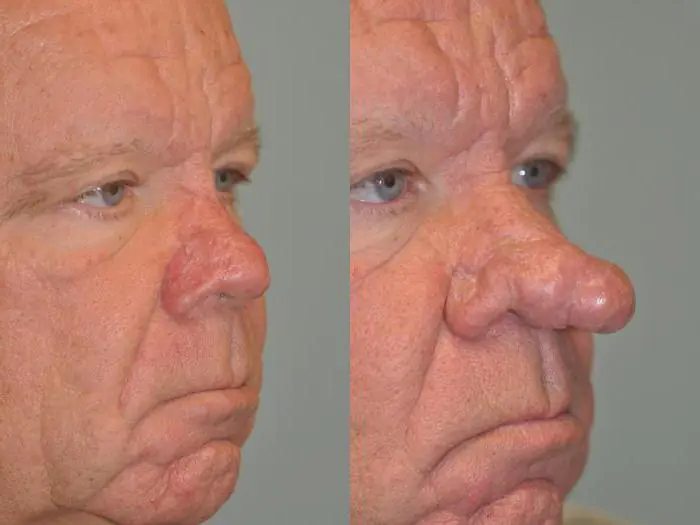
It is characterized by excessive growth of soft tissues and impaired respiratory function (in particularly difficult cases). Rhinophyma of the nose is a chronic disease that has a slow rate of development for a long time. However, a time comes when its progression accelerates.
As a result, the nose becomes very large and its appearance deteriorates significantly. In addition to tissue proliferation, a low-grade inflammatory process develops in a person in the affected area.
Rhinophyma of the nose develops much less frequently in women than in men. Moreover, in the latter, its progression is especially noticeable at the age of 40-50 years. Without proper treatment, the growths will continue to grow.
Most often, the disease manifests itself in people with fair hair and skin, and with hormonal imbalances. The development of pathology is facilitated by a constant strong temperature difference. It is also observed in those patients whose relatives have been diagnosed with rosacea.
Causes of the disease
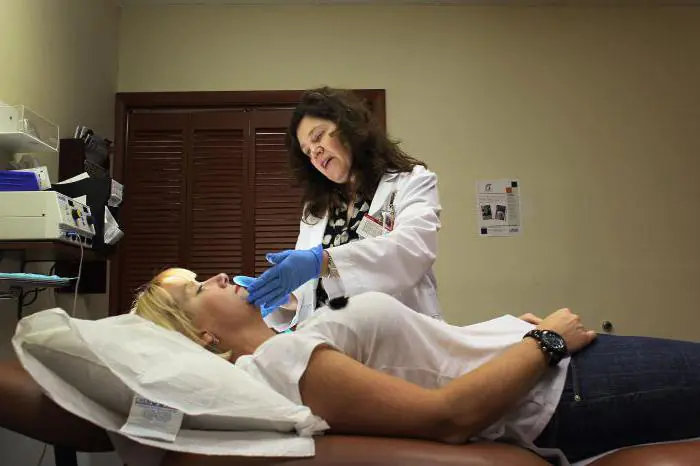
To date, they have not been precisely defined. Doctors suggest that if a patient is diagnosed with rhinophyma of the nose, the causes of this disease are as follows:
- Presence of skin mites.
- Inflammatory lesion of the epidermis.
However, it is known exactly what factors can trigger the development mechanism:
- Excessive alcohol abuse.
- The air is too dry or dusty.
- Pathologies of immunity.
- Disorders of the stomach and intestines.
- Long-term use of chemical medications.
- Direct exposure to sunlight.
- Age-related skin changes.
- Stress.
- Pathologies of blood vessels.
- Lack of vitamins in the body.
Classification of pathology
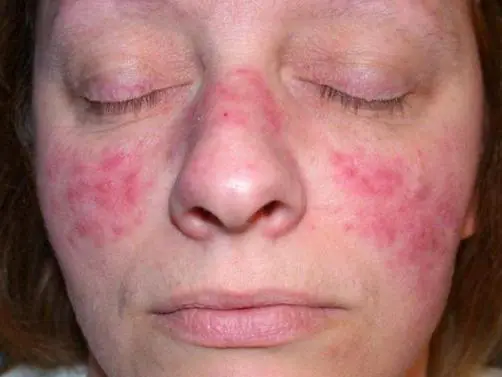
Rhinophyma of the nose can be hypertrophic and fibrous. In addition, there is another classification of pathology:
- Fibrous.
- Actinic.
- Granular.
- Fibrous-angiectatic.
The manifestations of the pathology depend on what type of pathology develops in the patient.
Symptoms of the disease

If a patient develops rhinophyma, the causes, symptoms and provoking factors should be considered so that the doctor can prescribe adequate treatment. So, depending on the form of the disease, the signs may be as follows:
- Fibrous. Here only the skin of the nose grows. In addition, small vessels dilate, although the surface of the affected part of the body remains smooth. The skin turns purple.
- Fibrous-angiectatic. In this case, tissue growth occurs evenly, that is, the externally natural contours of the nose practically do not change. The skin becomes red, and very bright, as new capillaries appear inside the formation. On the nose you can notice foci of inflammation that contain pus. This form of pathology is characterized by severe itching and pain.
- Actinic. It is more pronounced in those people who are often exposed to direct sunlight and who have light skin (hair). In this case, the tissue grows evenly, the blood vessels located on the wings of the nose expand. The code turns purple-brown.
- Granular. This is the most dangerous and unpleasant form of the development of the disease, since the patient experiences lumpy growths and the nose takes on an unnatural shape. The sebaceous glands also enlarge. When you press on the bumps, they release liquid with a bad odor. The changes affect not only the epidermis, but also cartilage tissue.
These symptoms are characteristic of almost all patients. Their severity depends on the degree of neglect of the disease, since not all patients seek medical help.
Diagnostic features
Rhinophyma of the nose is determined by visual examination of the patient. However, in order to take into account all the nuances of the pathology, the doctor is obliged to analyze the changed tissues. You can prescribe a biopsy to the patient to determine the nature of the formation: malignant or benign.
A laboratory scraping is also done to determine the presence of skin mites. Instrumental examination methods are not informative. Cytological and histological examinations are also performed.
Features of conservative therapy
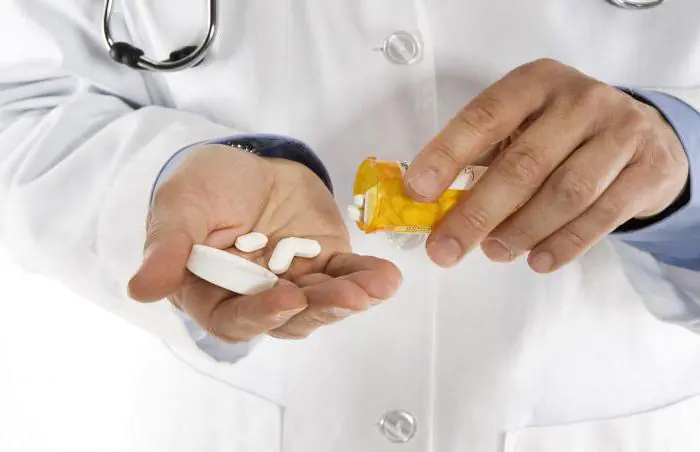
If a patient has nasal rhinophyma, treatment must be prescribed in the early stages of its development, before tissue proliferation has become irreversible. At first, conservative therapy is used. It includes the following drugs:
- Ointments and creams.
- Lotions based on boron or tannin composition. They provide an anti-inflammatory effect.
- Hormonal ointments and tablets, which are used when lighter medications are ineffective.
For a disease such as nasal rhinophyma, treatment with folk remedies will be ineffective. We are not talking about a simple inflammatory process, but about tissue proliferation, which is almost impossible to remove with herbal decoctions. Although some folk remedies can be prescribed by a doctor in the initial stages of pathology development.
Surgery
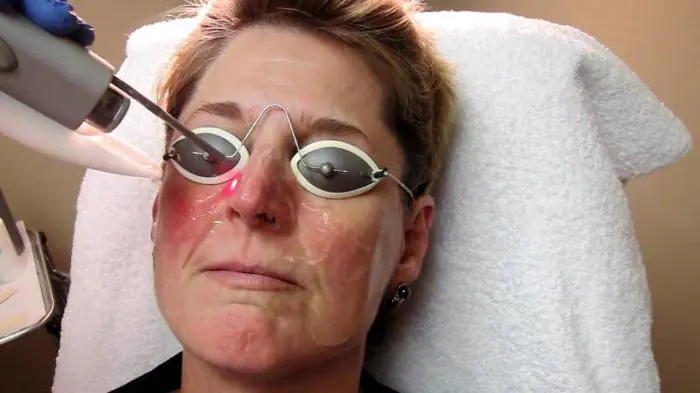
If conservative therapy does not give the desired effect, the doctor may resort to surgery. Small bumps are removed using laser therapy or electrocoagulation. A targeted effect is provided on the affected area, so after the operation the patient is left with a small wound. It heals very quickly, which speeds up the patient's recovery process.
Laser treatment is still considered the most effective. If the pathology is already in an advanced form, then surgery to restore the shape of the nose is recommended. In this case, a laser or an electric scalpel is used. Each type of surgical intervention is selected individually.
For example, if the growth is small, the specialist will perform dermabrasion - grinding the upper layers of the skin until a smooth wound surface is obtained. Next, natural restoration of the skin occurs.
More serious surgeries that require stitches may leave scars. More global plastic surgery is also possible. In this case, the surgeon removes all the affected tissue, after which the shape of the nose is adjusted.
Radio wave treatment is also used. It allows you not only to quickly remove overgrown tissue, but also to restore the natural shape of the affected part. With this method of intervention there is no bleeding or swelling. Postoperative complications in this case also practically do not appear.
After surgery, therapy with anti-inflammatory drugs is performed. Restoration of the epithelial layer occurs in 1-2 weeks. At the same time, the skin must be protected in every possible way from the effects of negative factors.
What complications may arise?
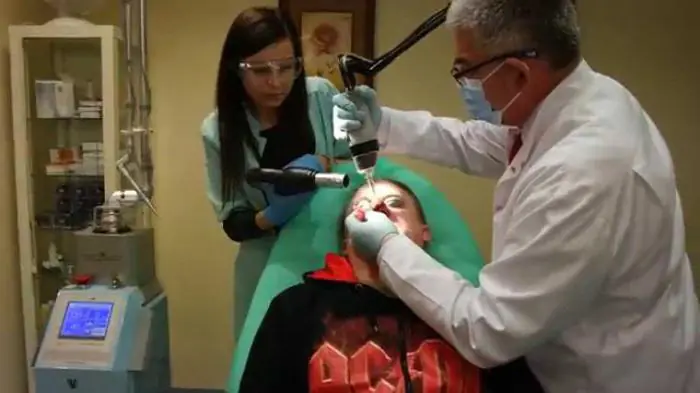
If the patient does not consult the doctor in a timely manner, he may experience the following complications:
- Aesthetic defect.
- Difficulty breathing as tissue nodules grow inward, blocking the nasal passages.
- Transition of formation into a malignant tumor.
In any case, it is better not to delay treatment. This way you can achieve a positive result faster.
Preventive measures
To prevent the pathology from appearing again, it is necessary to follow the following recommendations from specialists:
- Avoid prolonged exposure to cold or hot air, and do not stay in dusty areas.
- It is better to carefully protect yourself from direct exposure to sunlight using covered clothing or sunscreen.
- You should avoid going to the sauna or bathhouse.
- It's important to eat right.
- It is necessary to monitor the functionality of the stomach and intestines.
- It is important to carry out timely acne treatment.
- It is necessary to significantly limit the consumption of alcohol or give it up completely.
Only in this case will a man or woman be able to avoid relapses of the disease. That's all the information on the topic: "Rhinophyma of the nose: causes, symptoms, diagnosis and treatment." Of course, it is better to prevent a disease than to treat it. Therefore, a visit to the doctor should be made at the first manifestations of pathology. Be healthy!
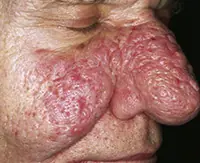
What factors can provoke such a serious disease as nasal rhinophyma? It is very important to recognize pathology in the early stages of development. There are modern methods of therapy that will help get rid of the disease.
There are pathologies that “prefer” to affect certain organs or body parts in the human body. These include rhinophyma of the nose. This disease develops only on this organ.
What is rhinophyma?
Rhinophyma is a pathology of the nose, which is classified as a benign tumor-like formation. A characteristic feature of the disease is an enlargement of all parts of the nose.
According to statistics, the pathology most often affects the male population over 40 years of age.
The disease has a long course, and its development occurs spasmodically. The inflammatory process in the skin provokes hypertrophy of blood vessels, sebaceous gland ducts, and connective tissue.

If tumors and redness appear on the nose, this is a reason to consult a doctor so as not to miss the development of nasal rhinophyma
There is another name for the disease - “wine nose”, or pineal nose.
Forms of rhinophyma
With the development of this pathology, a sharp increase in the size of the nose occurs, the blood vessels dilate, so the skin in this part acquires a shade from red to blue.
Doctors distinguish several forms of the disease:
- Glandular (glandular) rhinophyma. This form is most often diagnosed; it manifests itself by the appearance of tuberous growths on the wings and tip of the nose. Several small formations can merge into one. If you press on the pores on your nose, they release liquid with an unpleasant odor.
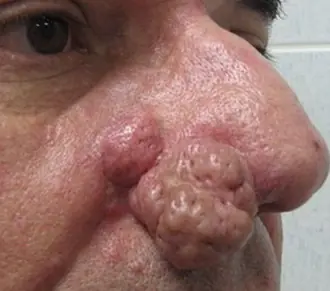
Small formations, if left untreated, will soon turn into huge growths
- Fibrous form the disease is rare. The skin on the nose thickens, but its shape does not change. The surface is without bumps or roughness.
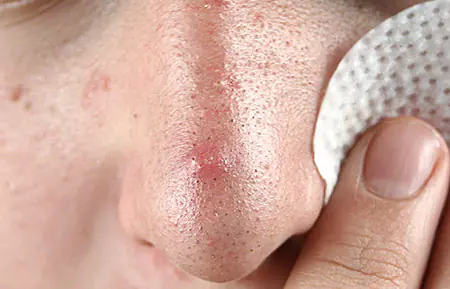
Thickening of the skin on the nose may be the first sign of the development of a serious disease.
- Actinic rhinophyma prefers to affect those who are prone to sunburn. The skin becomes thicker, a bluish tint appears, and growths appear on the wings of the nose. There is practically no smell, because the sebaceous glands do not grow.
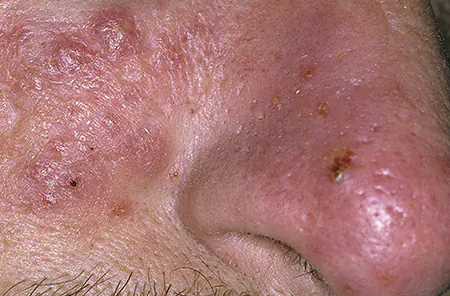
A love of sunbathing can lead to a serious problem with the skin on your nose.
- Fibrous-angiectatic pathology It is characterized by a uniform enlargement of the nose, the formations are soft, the skin acquires a crimson color. This form is characterized by the formation of multiple pustules.
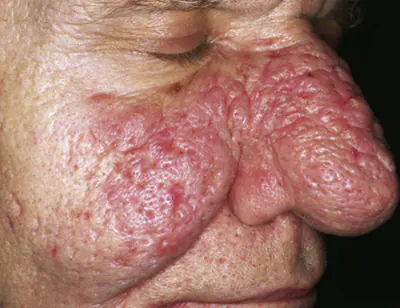
If the disease is not diagnosed in the early stages, then there is a risk of developing serious complications, which are then difficult to treat
Important! Other neoplasms of various origins may appear in the growing tissues of the nose, so a visit to a dermatologist is simply necessary.
Reasons for the development of the disease
This pathology has several reasons for its development:
- Microscopic demodex mites can provoke the appearance of rhinophyma.
- Chronic inflammatory processes of the skin.
In addition, several provoking factors can be identified that accelerate the development of pathology. These include:
- Sharp fluctuations in air temperature.
- Poor environmental situation.
- Alcohol abuse.

Love of alcoholic beverages is not only harmful to the whole body, but also the risk of developing a serious nasal disease
- Diseases of the gastrointestinal tract.
- Problems in the functioning of the endocrine system, hormonal imbalances.
- Impact of chemotherapy.
- Prolonged exposure to ultraviolet rays.
- Age-related changes in the body.
- Lack of certain vitamins and minerals.
- Frequent stress.
- Pathologies of the vascular system.
- Autoimmune diseases.
Need to know. Men are at risk; it is they who are most often overtaken by this pathology.
Stages of the disease
Rhinophyma is a disease whose treatment depends entirely on the stage of development. And there are several of them:
- The first stage is characterized by minor changes. You can see small roughness on the skin, blood vessels are visible. Therapy at this stage is most effective.
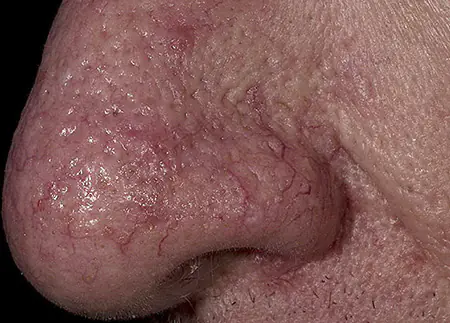
If the blood vessels on the skin of the nose become very visible and slight roughness appears, then this is a reason to rush to the dermatologist
- The next stage in the development of the disease is marked by an increase in the size of the nose, the skin acquires an uncharacteristic shade, and growths appear.
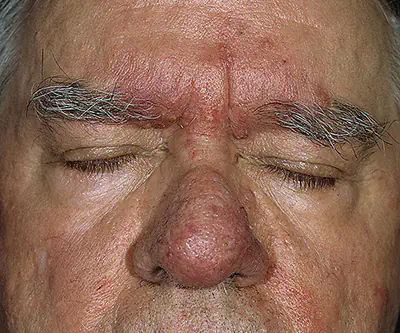
Lack of therapy at the first stage leads to further development of the disease
- At the last stage, the growths become pronounced, there may be several of them, small ones merge into one larger formation. The use of medications does not bring results.
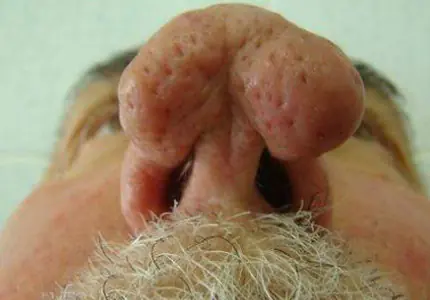
The symptoms of the last stage of development of nasal rhinophyma are such that it is almost impossible to avoid surgical intervention
Need to know! You should not use improvised means to get rid of such a pathology; only a competent specialist can provide effective assistance.
How to recognize the first signs of rhinophyma
This disease is characterized by a rather slow development. During a certain period, obvious pathological changes in the organ can be noted:
- The nose increases in size.
- Blood vessels are visible through the skin.
- The skin becomes uneven and roughness appears.
- The color of the skin changes, it becomes brownish, and as the pathology develops, the color will change.
The disease can develop in two ways:
- Acne. Patients notice a lot of acne on the nose; if you press on them, purulent contents with an unpleasant odor are released.
- The fibrotic variant of development involves a change in skin color, it becomes bluish, many red nodules appear, and the network of capillaries grows.
Rhinophyma of the nose - treatment
Depending on the stage of the pathology and the severity of symptoms, treatment of the disease is carried out in several directions:
- Drug therapy.
- Surgical intervention.
Important! There are no folk recipes for getting rid of this disease, regardless of the form and stage of development.
We fight rhinophyma with the help of medications
If the patient consulted a doctor in a timely manner when the disease was at an early stage of its development, then it is possible to use medication treatment. Medicines help improve blood flow and normalize the functioning of the gastrointestinal tract. The patient is prescribed:
- Medicines in the form of ointments on natural bases.

If you consult a doctor in a timely manner, the use of external agents will prevent further development of the pathology
- Lotions using boron or resorcinol compounds relieve inflammation well.
- If the disease progresses, hormonal drugs are prescribed in the form of ointments and tablets.
- If the cause of the development of pathology is endocrine diseases, means are used to normalize hormonal levels.
Surgical removal
If rhinophyma continues to grow and medications do not help, then surgical removal is indispensable. Doctors use several removal techniques:
- Dermabrasion. Used in the presence of small formations. The method involves mechanical grinding of the skin surface, old cells are removed, and new ones take their place. This method requires a long recovery period.
- Use of laser exposure. Rhinophyma disappears as a result of tissue evaporation, then their active restoration will begin.
- Radio wave surgery removes formations using radio waves. The advantages of the method are the absence of complications and rapid recovery.
- Surgical removal. Nowadays, this approach is used less and less, given the availability of modern techniques.
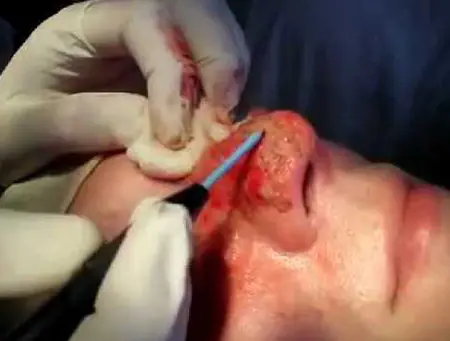
Complex forms of rhinophyma can only be cured with a surgical scalpel
Need to know. Rhinophyma is surgically removed under general anesthesia.
Complications of the disease
If you do not start therapy in the early stages of pathology development, the following complications may develop:
- Degeneration of a benign tumor into a malignant one.
- If large growths form, nasal breathing may become difficult.
- An unpleasant aesthetic effect, as the nose loses its previous shape and size.
Need to know. After treatment, rhinophyma can develop again if the therapy was carried out incorrectly or was not completed.
Prevention of disease development
It is impossible to completely insure against the development of pathology, but if you follow some recommendations, you can reduce the risk of its development:
- Minimize exposure to direct sunlight.
- If possible, avoid being in places with sudden changes in temperature and humidity.
- Do not abuse alcoholic beverages, but it is better to give them up altogether.
- Treat gastrointestinal diseases and endocrine pathologies in a timely manner.
- Correctly approach the treatment of acne and pimples on the skin.
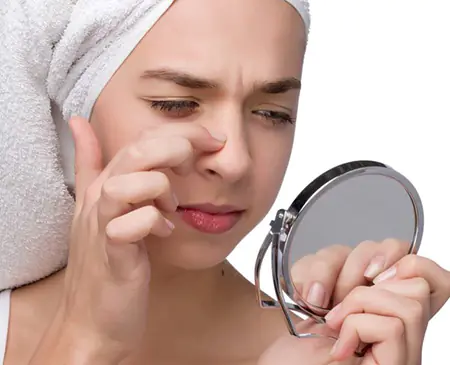
Timely treatment of acne and any rashes on the face will reduce the risk of developing nasal rhinophyma
Rhinophyma without appropriate treatment can quite disfigure the patient’s face, so you should not delay visiting a dermatologist. The earlier therapy is started, the better the result.
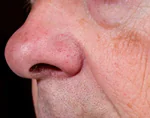
- Lumpy growths on the nose
- Purulent discharge with an unpleasant odor
- Nasal cartilage deformity
- Itching of the skin at the site of the lesion
- Sores on the nose
- Nose enlargement
- Enlarged blood vessels on the nose
- Acne
- Skin thickening on the nose
Rhinophyma is a benign tumor-like formation, which is characterized by proliferation and hypertrophy of the skin of the nose. It has secondary names such as wine nose, drunkard nose, pineal nose.
With this disease, the tissues of the nose grow greatly and become deformed. The disease is chronic and develops over a long period of time. The course of the disease fluctuates: at first, minor deviations from the norm are observed, and at a certain stage of exacerbation there is a sharp jump in the growth of the pathological process.
With a long course of the pathology, the nose becomes greatly enlarged, blood vessels become visible, the skin tissues become lumpy and pronounced, the color shade can change from scarlet to blue or purple. This process is accompanied by inflammation. Not only the tissue itself increases, but also the structural units.
The pathology is most often diagnosed in men over forty years of age, and is rarely found in women. Treatment is selected individually: laser, conservative methods. Sometimes traditional medicine is used, but only as an addition to the main therapy.
Etiology
Rhinophyma of the nose is a benign neoplasm, does not pose a threat to human life, but causes aesthetic discomfort, violating symmetry and proportions. When all parts of the nose become enlarged, there is an increase in secretions in the sebaceous glands, which can cause an unpleasant odor.
Despite the benign nature of the disease, isolated cases of tissue degeneration into a malignant process have been recorded. If the symptoms do not include acne, then the disease is considered as an independent entity.
Scientists identify the following causes of this disease:
- constant overheating or hypothermia;
- increased humidity or dry air;
- harmful working conditions and lack of protective equipment (mask with filter);
- endocrine and hormonal disorders;
- constant overload of the body;
- improper and inadequate nutrition;
- with alcoholism and inhalation of drugs;
- existing dermatological problems;
- after therapy for cancer;
- the presence of congenital pathologies of the skin and blood vessels.
Sometimes a combination of several factors leads to the development of pathological processes.
Classification
Rhinophyma in medicine has two classifications.
The first is divided into the following forms:
- Fibrous-angiectatic form. It is characterized by uniform growth of nasal tissues, maintaining a natural outline. The skin becomes bright red due to the formation of additional blood vessels. Purulent inflammatory foci appear on the upper layer of the skin of the nose, and after they open, a crust forms, which, when dried, causes itching and soreness of the nose.
- Actinic form. It is characterized by uniform growth - the vessels on the wings of the nose expand. This type of disease applies to people with white skin who are exposed to sunlight for a long time.
- Glandular or glandular form. With it, the tissues grow in tubercles, their shape resembles tubers, like potatoes, the outlines of the nose become blurred, and the sebaceous glands grow rapidly. When you press on areas with pathology, sebum and pus are released, and the cartilage tissue changes.
- Fibrous form. This pathology is manifested only by deformation of the skin, the number of capillaries increases, while the surface of the nose remains smooth, acquiring a purple tint.
According to the second classification, the following forms are distinguished:
- Hypertrophic, when acne appears on the nose, protruding above the surface of normal skin, localized on the wings of the nose. The sebaceous glands enlarge, the pores expand, and when you press on areas with pathology, pus with an unpleasant odor appears, and the skin on the nose thickens.
- Fibrous - there are many bumps, the color changes from red to purple, the vessels change, dilate and thicken.
The disease has a rather unpleasant appearance and causes discomfort in the nasal area.
Symptoms
Depending on the form of the disease, symptoms will differ.
The general symptoms are as follows:
- nose enlargement;
- the appearance of lumpy neoplasms;
- blood vessels enlarge;
- there is severe inflammation;
- purulent discharge with an unpleasant odor occurs;
- wounds form that do not heal well;
- severe itching with pain appears;
- cartilage deformation is observed under the pressure of the neoplasm.
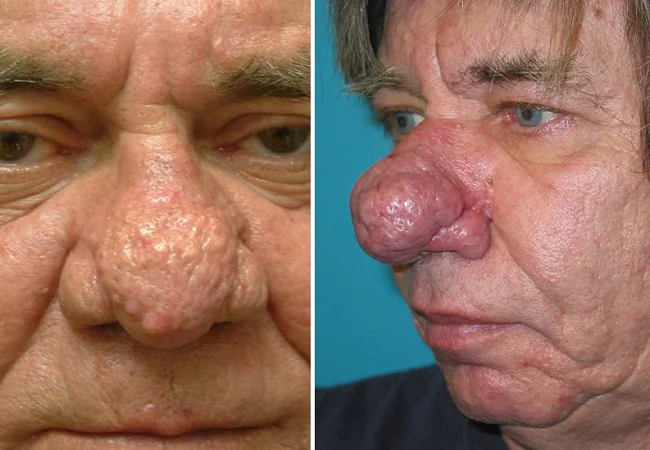
Despite the fact that rhinophyma is benign, it still requires timely treatment.
Diagnostics
Rhinophyma disease is determined by visual examination, then the severity of the disease is determined, and the condition of the sebaceous glands is studied. To rule out cancer, a biopsy is taken.
The following laboratory tests are carried out:
- a scraping is taken to check for parasites;
- hormonal levels are checked;
- the gastrointestinal tract is examined;
- a blood test is done.
The specialist must differentiate this disease from other diseases.
Treatment
Treatment for rhinophyma is as follows:
- conservative therapy (lotions, creams, hormonal drugs) is effective only at the onset of the disease and if there is no tissue death and severe inflammation;
- the top layer of skin is removed - this method is also effective at the beginning of the disease, when the tissues have not grown much;
- excision of the tumor using a subcutaneous method - the technique is effective, but requires further plastic surgery;
- elimination using a laser - carried out only in the first stages of the disease, when the tumor covers a small area;
- radio wave therapy - allows you to destroy pathology and restore tissue, does not cause bleeding or swelling;
- plastic surgery – aimed at removing rhinophyma and restoring the shape of the nose.
For all types of non-conservative interventions, patients are prescribed anti-inflammatory, antimicrobial and fortified drugs.
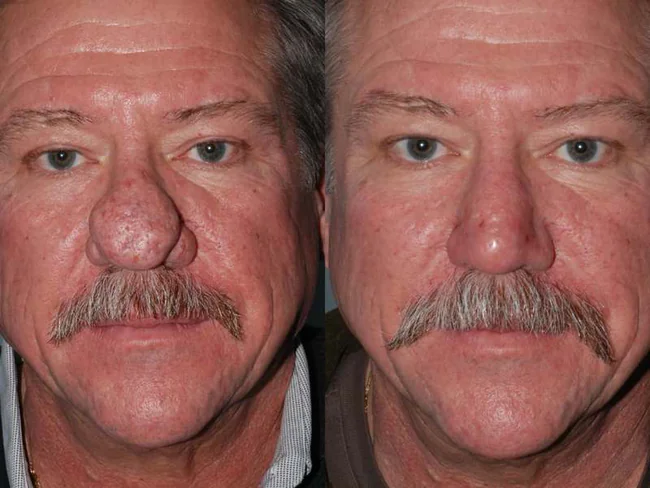
Treatment with folk remedies is allowed, but first limit the consumption of foods that promote vasodilation: alcohol, fatty and spicy foods, drinks containing caffeine.
- chamomile decoction;
- aloe juice – has an anti-inflammatory effect;
- potato masks;
- cucumber compresses.
Traditional medicine is effective at the stage of the cause: for acne, when the skin is chapped or overcooled. However, folk remedies are not used as the main method of treatment when the pathology has taken shape.
Possible complications
If you do not consult a specialist in a timely manner and allow the pathology to reach its peak in development, you can get the following complications:
- labored breathing;
- necrosis of the skin;
- the neoplasm will become malignant;
- infection can be caused by poor wound treatment;
In any case, at the first sign of deviation from the norm, you should contact the clinic to receive high-quality diagnostics and therapy.
Prevention
After all procedures, cases of disease recurrence were recorded, since not all tissues were eliminated.
To prevent recurrent conditions, the following measures must be taken:
- do not stay in the sun, cold and wind for a long time;
- use creams or sunscreen ointments;
- do not visit the sauna or steam bath;
- eat healthy;
- monitor the condition of the digestive organs;
- Treat acne in a timely manner.
You need to lead a healthy lifestyle and strengthen your immune system.



